RMIT Aerospace Engineering Program Compared to Global Standards
VerifiedAdded on 2023/06/03
|19
|5650
|435
Thesis and Dissertation
AI Summary
This thesis, titled "Aerospace Engineering Undergraduate program around the globe compared to RMIT," provides a comprehensive comparative analysis of undergraduate aerospace engineering programs offered by various universities worldwide. The study begins with an introduction to aerospace engineering, its core principles, and the roles of aerospace engineers, followed by a literature review of program structures, curricula, internships, and research opportunities at top-ranked universities, including MIT, Stanford, and Georgia Tech. The thesis examines key aspects such as core curriculum, professional area subjects, experimental and capstone projects, internships, and research opportunities. The methodology involves a detailed examination of program structures, course requirements, and practical experiences offered by these institutions, highlighting the diverse approaches to aerospace engineering education. The thesis aims to provide a comparative framework for understanding the strengths and weaknesses of different program designs and their effectiveness in preparing students for careers in the aerospace industry. The document is a valuable resource for students seeking insights into aerospace engineering education and program selection.

“Jay Naag Deuta Anusha Thapa Magar Ale”
“Masters thesis”
“Aerospace Engineering Undergraduate program around the globe
compared to RMIT”
Abstract
Introduction
The currently existing more than 500 universities and colleges offering undergraduate
degree in Aerospace/Aeronautical engineering has their own unique program structure
and ways of running the program that best suits the students and helps them in developing
skillset and understanding of the aerospace engineering. Aerospace engineering itself is the
newest branch of engineering so to best understand the program a student has to undergo,
to qualify as an aerospace engineer, it is fundamental to know what is aerospace
engineering and what do an aerospace engineer do.
First and foremost it is necessary to understand what is engineering. Engineering is “The
action of working artfully to bring something about” and also “The branch of science and
technology concerned with the design, building, and use of engines, machines, and structures.”
Oxford Dictionary
So Aerospace engineering is an art and branch of science and technology that deals with
the designing, developing and building of the machines that fly. It is combination of two
branches of engineering Aeronautical Engineering concerned with the aircrafts that flies
within the earth’s atmosphere and Astronautical engineering that deals with space beyond
earth’s atmosphere. To be an Aerospace engineer you need an engineering degree from
university or college with a major in aeronautical or aerospace engineering with
prerequisite of subjects such as Mathematics, Science, Chemistry, Physics and English.
There are large numbers of universities and colleges all over the world offering a degree in
Aerospace and Aeronautical engineering. Each institution has different prerequisites and
curriculum, requirements, syllabus designed by their respective departments..
Literature Review
To understand the teaching practice it is important to review the undergraduate program
of universities around the globe. Program structure, curriculum, internships and research
projects of top universities around the globe as ranked by “The Times Higher Education “
world university rankings and “Academic ranking of the world” and QS world university
Ranking based on subjects Mechanical, Aeronautical and Manufacturing Engineering.
Undergraduate Aerospace Engineering Program of Top universities
1. Massachussets Institute of technology (USA)
“Masters thesis”
“Aerospace Engineering Undergraduate program around the globe
compared to RMIT”
Abstract
Introduction
The currently existing more than 500 universities and colleges offering undergraduate
degree in Aerospace/Aeronautical engineering has their own unique program structure
and ways of running the program that best suits the students and helps them in developing
skillset and understanding of the aerospace engineering. Aerospace engineering itself is the
newest branch of engineering so to best understand the program a student has to undergo,
to qualify as an aerospace engineer, it is fundamental to know what is aerospace
engineering and what do an aerospace engineer do.
First and foremost it is necessary to understand what is engineering. Engineering is “The
action of working artfully to bring something about” and also “The branch of science and
technology concerned with the design, building, and use of engines, machines, and structures.”
Oxford Dictionary
So Aerospace engineering is an art and branch of science and technology that deals with
the designing, developing and building of the machines that fly. It is combination of two
branches of engineering Aeronautical Engineering concerned with the aircrafts that flies
within the earth’s atmosphere and Astronautical engineering that deals with space beyond
earth’s atmosphere. To be an Aerospace engineer you need an engineering degree from
university or college with a major in aeronautical or aerospace engineering with
prerequisite of subjects such as Mathematics, Science, Chemistry, Physics and English.
There are large numbers of universities and colleges all over the world offering a degree in
Aerospace and Aeronautical engineering. Each institution has different prerequisites and
curriculum, requirements, syllabus designed by their respective departments..
Literature Review
To understand the teaching practice it is important to review the undergraduate program
of universities around the globe. Program structure, curriculum, internships and research
projects of top universities around the globe as ranked by “The Times Higher Education “
world university rankings and “Academic ranking of the world” and QS world university
Ranking based on subjects Mechanical, Aeronautical and Manufacturing Engineering.
Undergraduate Aerospace Engineering Program of Top universities
1. Massachussets Institute of technology (USA)
Secure Best Marks with AI Grader
Need help grading? Try our AI Grader for instant feedback on your assignments.
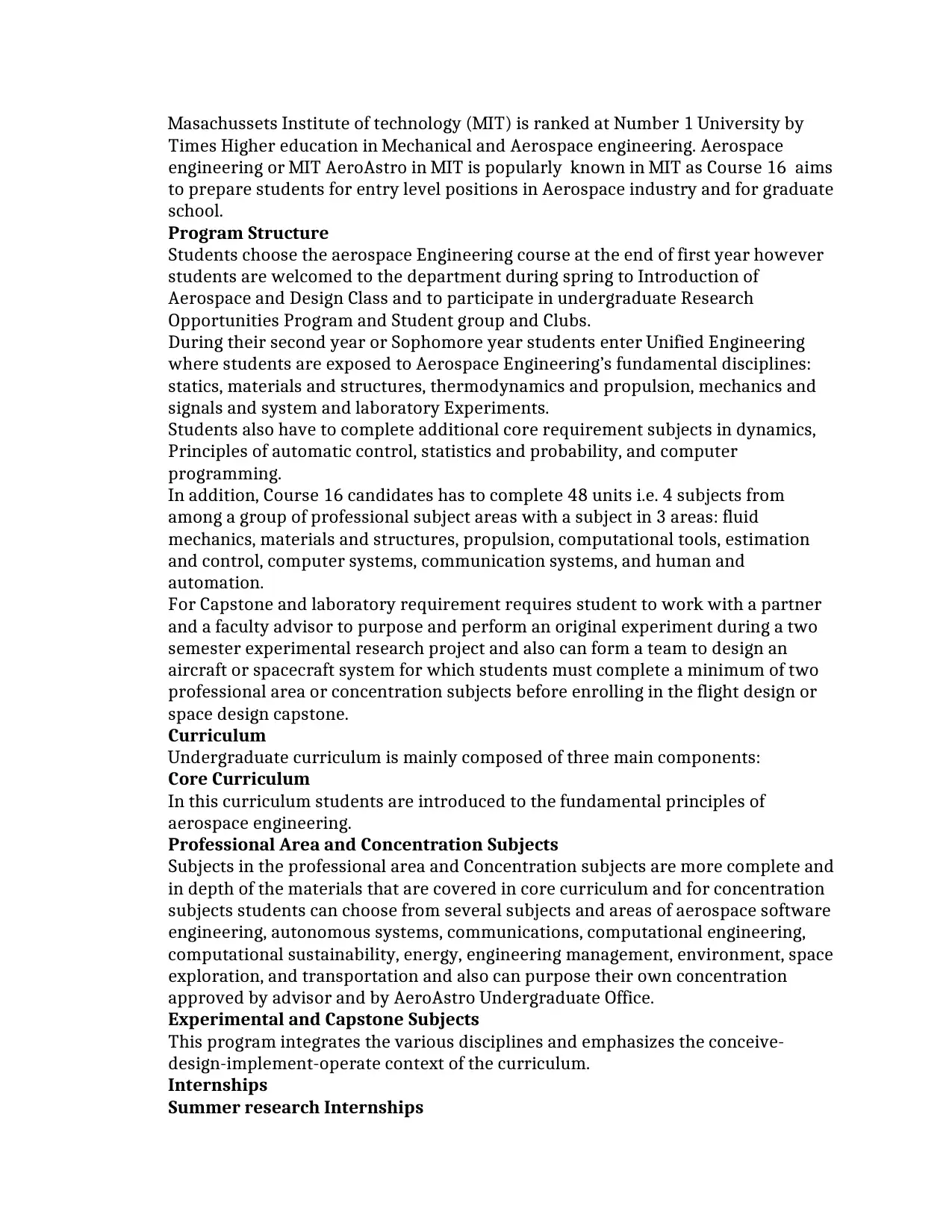
Masachussets Institute of technology (MIT) is ranked at Number 1 University by
Times Higher education in Mechanical and Aerospace engineering. Aerospace
engineering or MIT AeroAstro in MIT is popularly known in MIT as Course 16 aims
to prepare students for entry level positions in Aerospace industry and for graduate
school.
Program Structure
Students choose the aerospace Engineering course at the end of first year however
students are welcomed to the department during spring to Introduction of
Aerospace and Design Class and to participate in undergraduate Research
Opportunities Program and Student group and Clubs.
During their second year or Sophomore year students enter Unified Engineering
where students are exposed to Aerospace Engineering’s fundamental disciplines:
statics, materials and structures, thermodynamics and propulsion, mechanics and
signals and system and laboratory Experiments.
Students also have to complete additional core requirement subjects in dynamics,
Principles of automatic control, statistics and probability, and computer
programming.
In addition, Course 16 candidates has to complete 48 units i.e. 4 subjects from
among a group of professional subject areas with a subject in 3 areas: fluid
mechanics, materials and structures, propulsion, computational tools, estimation
and control, computer systems, communication systems, and human and
automation.
For Capstone and laboratory requirement requires student to work with a partner
and a faculty advisor to purpose and perform an original experiment during a two
semester experimental research project and also can form a team to design an
aircraft or spacecraft system for which students must complete a minimum of two
professional area or concentration subjects before enrolling in the flight design or
space design capstone.
Curriculum
Undergraduate curriculum is mainly composed of three main components:
Core Curriculum
In this curriculum students are introduced to the fundamental principles of
aerospace engineering.
Professional Area and Concentration Subjects
Subjects in the professional area and Concentration subjects are more complete and
in depth of the materials that are covered in core curriculum and for concentration
subjects students can choose from several subjects and areas of aerospace software
engineering, autonomous systems, communications, computational engineering,
computational sustainability, energy, engineering management, environment, space
exploration, and transportation and also can purpose their own concentration
approved by advisor and by AeroAstro Undergraduate Office.
Experimental and Capstone Subjects
This program integrates the various disciplines and emphasizes the conceive-
design-implement-operate context of the curriculum.
Internships
Summer research Internships
Times Higher education in Mechanical and Aerospace engineering. Aerospace
engineering or MIT AeroAstro in MIT is popularly known in MIT as Course 16 aims
to prepare students for entry level positions in Aerospace industry and for graduate
school.
Program Structure
Students choose the aerospace Engineering course at the end of first year however
students are welcomed to the department during spring to Introduction of
Aerospace and Design Class and to participate in undergraduate Research
Opportunities Program and Student group and Clubs.
During their second year or Sophomore year students enter Unified Engineering
where students are exposed to Aerospace Engineering’s fundamental disciplines:
statics, materials and structures, thermodynamics and propulsion, mechanics and
signals and system and laboratory Experiments.
Students also have to complete additional core requirement subjects in dynamics,
Principles of automatic control, statistics and probability, and computer
programming.
In addition, Course 16 candidates has to complete 48 units i.e. 4 subjects from
among a group of professional subject areas with a subject in 3 areas: fluid
mechanics, materials and structures, propulsion, computational tools, estimation
and control, computer systems, communication systems, and human and
automation.
For Capstone and laboratory requirement requires student to work with a partner
and a faculty advisor to purpose and perform an original experiment during a two
semester experimental research project and also can form a team to design an
aircraft or spacecraft system for which students must complete a minimum of two
professional area or concentration subjects before enrolling in the flight design or
space design capstone.
Curriculum
Undergraduate curriculum is mainly composed of three main components:
Core Curriculum
In this curriculum students are introduced to the fundamental principles of
aerospace engineering.
Professional Area and Concentration Subjects
Subjects in the professional area and Concentration subjects are more complete and
in depth of the materials that are covered in core curriculum and for concentration
subjects students can choose from several subjects and areas of aerospace software
engineering, autonomous systems, communications, computational engineering,
computational sustainability, energy, engineering management, environment, space
exploration, and transportation and also can purpose their own concentration
approved by advisor and by AeroAstro Undergraduate Office.
Experimental and Capstone Subjects
This program integrates the various disciplines and emphasizes the conceive-
design-implement-operate context of the curriculum.
Internships
Summer research Internships
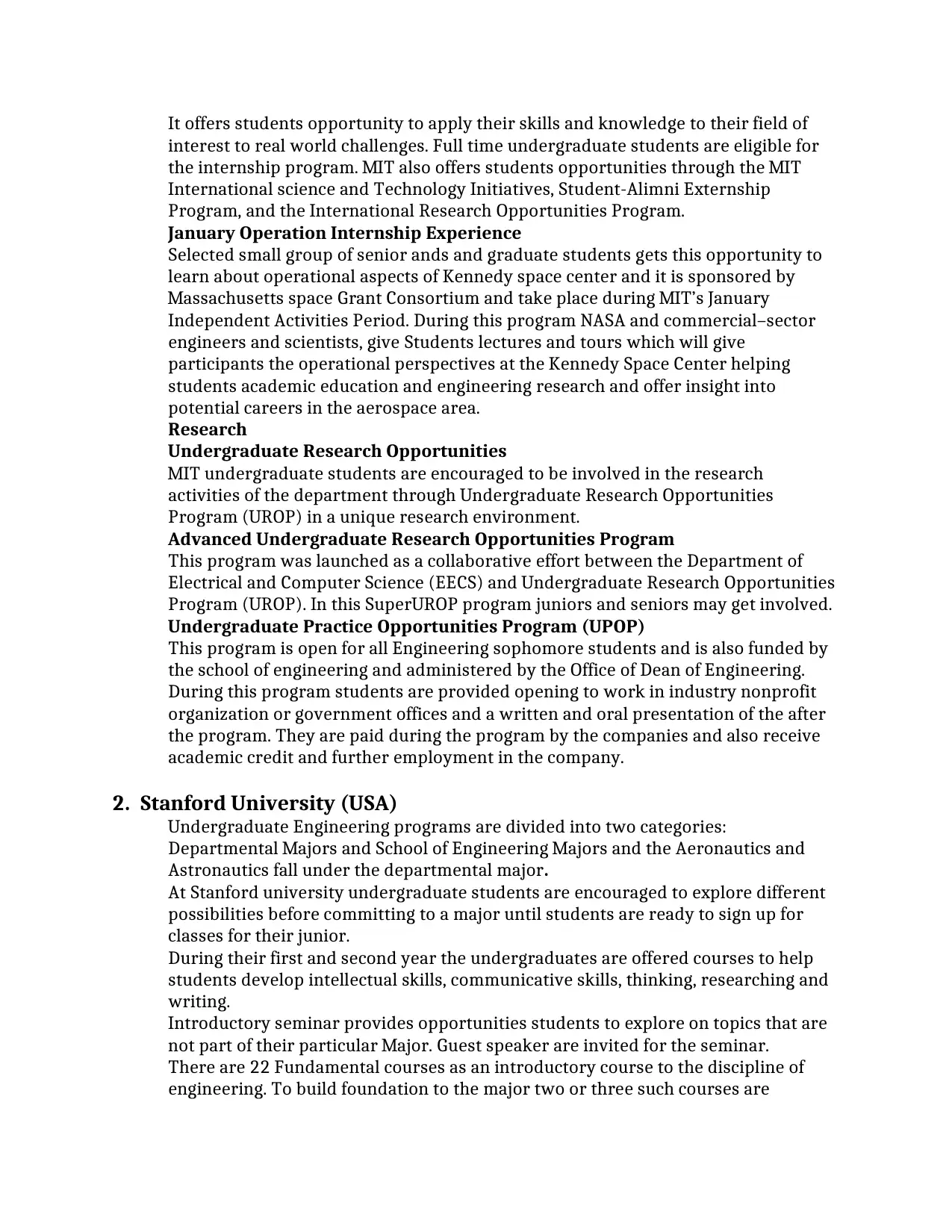
It offers students opportunity to apply their skills and knowledge to their field of
interest to real world challenges. Full time undergraduate students are eligible for
the internship program. MIT also offers students opportunities through the MIT
International science and Technology Initiatives, Student-Alimni Externship
Program, and the International Research Opportunities Program.
January Operation Internship Experience
Selected small group of senior ands and graduate students gets this opportunity to
learn about operational aspects of Kennedy space center and it is sponsored by
Massachusetts space Grant Consortium and take place during MIT’s January
Independent Activities Period. During this program NASA and commercial–sector
engineers and scientists, give Students lectures and tours which will give
participants the operational perspectives at the Kennedy Space Center helping
students academic education and engineering research and offer insight into
potential careers in the aerospace area.
Research
Undergraduate Research Opportunities
MIT undergraduate students are encouraged to be involved in the research
activities of the department through Undergraduate Research Opportunities
Program (UROP) in a unique research environment.
Advanced Undergraduate Research Opportunities Program
This program was launched as a collaborative effort between the Department of
Electrical and Computer Science (EECS) and Undergraduate Research Opportunities
Program (UROP). In this SuperUROP program juniors and seniors may get involved.
Undergraduate Practice Opportunities Program (UPOP)
This program is open for all Engineering sophomore students and is also funded by
the school of engineering and administered by the Office of Dean of Engineering.
During this program students are provided opening to work in industry nonprofit
organization or government offices and a written and oral presentation of the after
the program. They are paid during the program by the companies and also receive
academic credit and further employment in the company.
2. Stanford University (USA)
Undergraduate Engineering programs are divided into two categories:
Departmental Majors and School of Engineering Majors and the Aeronautics and
Astronautics fall under the departmental major.
At Stanford university undergraduate students are encouraged to explore different
possibilities before committing to a major until students are ready to sign up for
classes for their junior.
During their first and second year the undergraduates are offered courses to help
students develop intellectual skills, communicative skills, thinking, researching and
writing.
Introductory seminar provides opportunities students to explore on topics that are
not part of their particular Major. Guest speaker are invited for the seminar.
There are 22 Fundamental courses as an introductory course to the discipline of
engineering. To build foundation to the major two or three such courses are
interest to real world challenges. Full time undergraduate students are eligible for
the internship program. MIT also offers students opportunities through the MIT
International science and Technology Initiatives, Student-Alimni Externship
Program, and the International Research Opportunities Program.
January Operation Internship Experience
Selected small group of senior ands and graduate students gets this opportunity to
learn about operational aspects of Kennedy space center and it is sponsored by
Massachusetts space Grant Consortium and take place during MIT’s January
Independent Activities Period. During this program NASA and commercial–sector
engineers and scientists, give Students lectures and tours which will give
participants the operational perspectives at the Kennedy Space Center helping
students academic education and engineering research and offer insight into
potential careers in the aerospace area.
Research
Undergraduate Research Opportunities
MIT undergraduate students are encouraged to be involved in the research
activities of the department through Undergraduate Research Opportunities
Program (UROP) in a unique research environment.
Advanced Undergraduate Research Opportunities Program
This program was launched as a collaborative effort between the Department of
Electrical and Computer Science (EECS) and Undergraduate Research Opportunities
Program (UROP). In this SuperUROP program juniors and seniors may get involved.
Undergraduate Practice Opportunities Program (UPOP)
This program is open for all Engineering sophomore students and is also funded by
the school of engineering and administered by the Office of Dean of Engineering.
During this program students are provided opening to work in industry nonprofit
organization or government offices and a written and oral presentation of the after
the program. They are paid during the program by the companies and also receive
academic credit and further employment in the company.
2. Stanford University (USA)
Undergraduate Engineering programs are divided into two categories:
Departmental Majors and School of Engineering Majors and the Aeronautics and
Astronautics fall under the departmental major.
At Stanford university undergraduate students are encouraged to explore different
possibilities before committing to a major until students are ready to sign up for
classes for their junior.
During their first and second year the undergraduates are offered courses to help
students develop intellectual skills, communicative skills, thinking, researching and
writing.
Introductory seminar provides opportunities students to explore on topics that are
not part of their particular Major. Guest speaker are invited for the seminar.
There are 22 Fundamental courses as an introductory course to the discipline of
engineering. To build foundation to the major two or three such courses are

required to acquire knowledge outside of their major they intend to choose and also
consider choosing one fundamental course they plan to choose as major.
Aeronautics and Astronautics
Aeronautics and astronautics program is a broad program integrating multiple
disciplines of engineering emphasizing aerodynamic, structure, guidance and
control, and propulsion of aircraft and spacecraft. It prepares students for careers in
aircraft and spacecraft engineering, autonomy, robotics, unmanned Aerial Vehicles,
drones, space exploration, air and space based telecommunication industries,
computational engineering, teaching, research, military service and other relative
fields.
Curriculum
Prerequisite for Aeronautics and astronautics depth Course
As a prerequisite for the course students has to complete:
24 units of mathematics from Single –variable calculus, vector calculus, linear
algebra and differential Calculus of several Variables, probability and statistics and
highly recommended math courses Linear Algebra and Partial Differential
Equations and Introduction to Scientific Computing.
20 units of science from Physics: Mechanics, concepts, Calculations and context,
Electricity Magnetism and Heat and Lights well as Chemistry subjects Chemical
Principles and one course of Technology in society equivalent to 3-5 units is
required before entering this departmental major
Curriculum for departmental Major in Aeronautics and astronautics include:
Engineering Fundamental course
Undergraduates need to complete 11 units minimum from 17 total units of
Engineering Fundamentals from engineering of systems, programing Methodology,
Introduction to engineering
Aeronautics and Astronautics depth requirements
Students are required to complete 27 units minimum foe depth requirements from
subjects, solid Mechanics, dynamics, control, thermodynamics, introduction to
aeronautics and Astronautics, introduction to applied Aerodynamics, Air and space
propulsion, space flight, atmospheric flight and directed research and writing in
Aero/Astro.
Aeronautics and astronautics Focus Electives
Minimum of 15 units are required to complete among Aerospace computational
engineering, space policy. Lightweight structures, composite materials, flight
controls and mechanics, embedded programming, global positioning system, space
mechanics, operation of Aerospace systems, Independent study in Aero/AStro and
the spirit of Entrepreneurship
Aeronautics and Astronautics Capstone
For Capstone students has to select complete 7 units and one sequence from Air
Capstone I and Ais capstone II or Space Capstone I and Space Capstone II.
Research
They have designed a Research Ecperience for undergraduates (REU) program
jointly coordinated by the Office of Undergraduate Education and the Office of
student Affairs in school of Engineering and the Astronautics and Aeronautics
consider choosing one fundamental course they plan to choose as major.
Aeronautics and Astronautics
Aeronautics and astronautics program is a broad program integrating multiple
disciplines of engineering emphasizing aerodynamic, structure, guidance and
control, and propulsion of aircraft and spacecraft. It prepares students for careers in
aircraft and spacecraft engineering, autonomy, robotics, unmanned Aerial Vehicles,
drones, space exploration, air and space based telecommunication industries,
computational engineering, teaching, research, military service and other relative
fields.
Curriculum
Prerequisite for Aeronautics and astronautics depth Course
As a prerequisite for the course students has to complete:
24 units of mathematics from Single –variable calculus, vector calculus, linear
algebra and differential Calculus of several Variables, probability and statistics and
highly recommended math courses Linear Algebra and Partial Differential
Equations and Introduction to Scientific Computing.
20 units of science from Physics: Mechanics, concepts, Calculations and context,
Electricity Magnetism and Heat and Lights well as Chemistry subjects Chemical
Principles and one course of Technology in society equivalent to 3-5 units is
required before entering this departmental major
Curriculum for departmental Major in Aeronautics and astronautics include:
Engineering Fundamental course
Undergraduates need to complete 11 units minimum from 17 total units of
Engineering Fundamentals from engineering of systems, programing Methodology,
Introduction to engineering
Aeronautics and Astronautics depth requirements
Students are required to complete 27 units minimum foe depth requirements from
subjects, solid Mechanics, dynamics, control, thermodynamics, introduction to
aeronautics and Astronautics, introduction to applied Aerodynamics, Air and space
propulsion, space flight, atmospheric flight and directed research and writing in
Aero/Astro.
Aeronautics and astronautics Focus Electives
Minimum of 15 units are required to complete among Aerospace computational
engineering, space policy. Lightweight structures, composite materials, flight
controls and mechanics, embedded programming, global positioning system, space
mechanics, operation of Aerospace systems, Independent study in Aero/AStro and
the spirit of Entrepreneurship
Aeronautics and Astronautics Capstone
For Capstone students has to select complete 7 units and one sequence from Air
Capstone I and Ais capstone II or Space Capstone I and Space Capstone II.
Research
They have designed a Research Ecperience for undergraduates (REU) program
jointly coordinated by the Office of Undergraduate Education and the Office of
student Affairs in school of Engineering and the Astronautics and Aeronautics
Secure Best Marks with AI Grader
Need help grading? Try our AI Grader for instant feedback on your assignments.
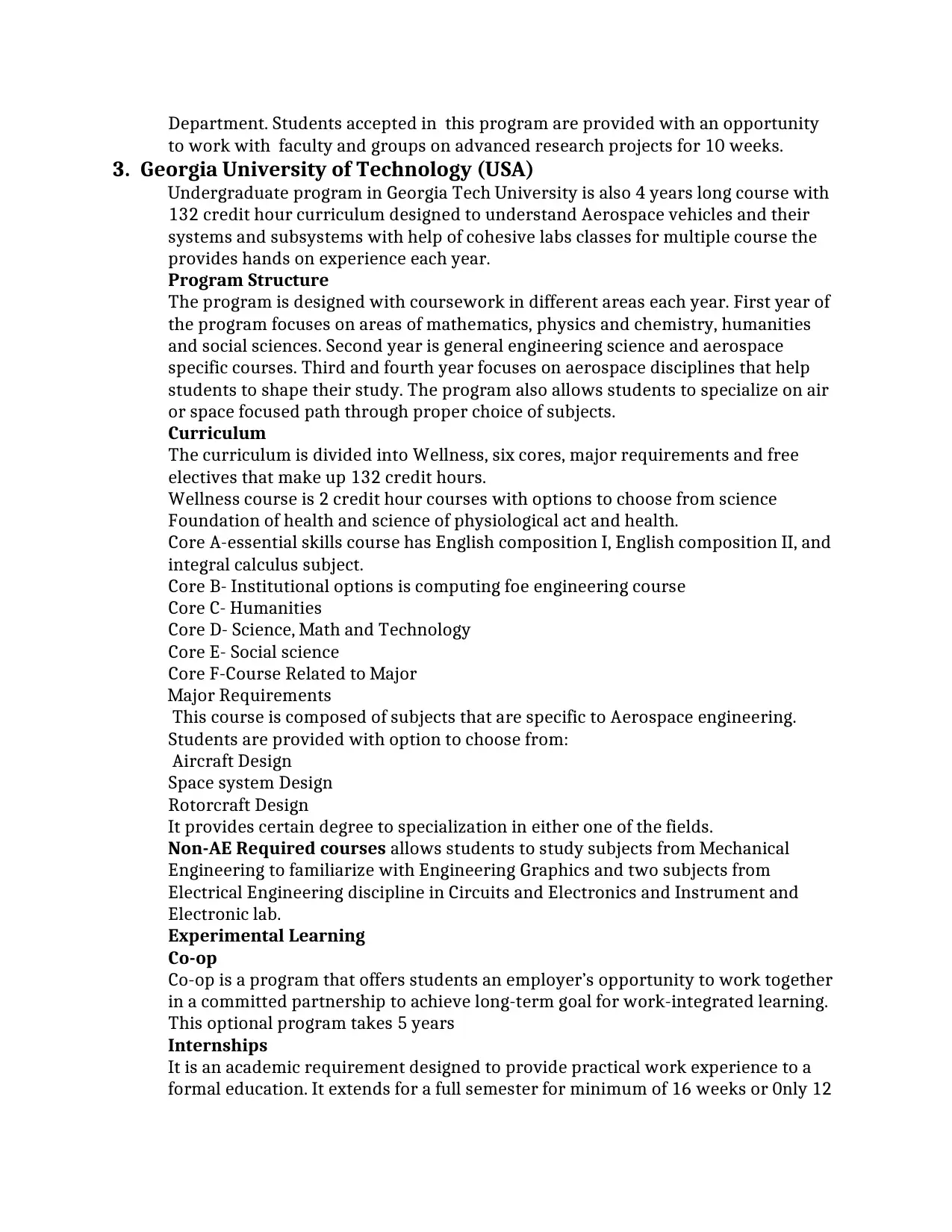
Department. Students accepted in this program are provided with an opportunity
to work with faculty and groups on advanced research projects for 10 weeks.
3. Georgia University of Technology (USA)
Undergraduate program in Georgia Tech University is also 4 years long course with
132 credit hour curriculum designed to understand Aerospace vehicles and their
systems and subsystems with help of cohesive labs classes for multiple course the
provides hands on experience each year.
Program Structure
The program is designed with coursework in different areas each year. First year of
the program focuses on areas of mathematics, physics and chemistry, humanities
and social sciences. Second year is general engineering science and aerospace
specific courses. Third and fourth year focuses on aerospace disciplines that help
students to shape their study. The program also allows students to specialize on air
or space focused path through proper choice of subjects.
Curriculum
The curriculum is divided into Wellness, six cores, major requirements and free
electives that make up 132 credit hours.
Wellness course is 2 credit hour courses with options to choose from science
Foundation of health and science of physiological act and health.
Core A-essential skills course has English composition I, English composition II, and
integral calculus subject.
Core B- Institutional options is computing foe engineering course
Core C- Humanities
Core D- Science, Math and Technology
Core E- Social science
Core F-Course Related to Major
Major Requirements
This course is composed of subjects that are specific to Aerospace engineering.
Students are provided with option to choose from:
Aircraft Design
Space system Design
Rotorcraft Design
It provides certain degree to specialization in either one of the fields.
Non-AE Required courses allows students to study subjects from Mechanical
Engineering to familiarize with Engineering Graphics and two subjects from
Electrical Engineering discipline in Circuits and Electronics and Instrument and
Electronic lab.
Experimental Learning
Co-op
Co-op is a program that offers students an employer’s opportunity to work together
in a committed partnership to achieve long-term goal for work-integrated learning.
This optional program takes 5 years
Internships
It is an academic requirement designed to provide practical work experience to a
formal education. It extends for a full semester for minimum of 16 weeks or 0nly 12
to work with faculty and groups on advanced research projects for 10 weeks.
3. Georgia University of Technology (USA)
Undergraduate program in Georgia Tech University is also 4 years long course with
132 credit hour curriculum designed to understand Aerospace vehicles and their
systems and subsystems with help of cohesive labs classes for multiple course the
provides hands on experience each year.
Program Structure
The program is designed with coursework in different areas each year. First year of
the program focuses on areas of mathematics, physics and chemistry, humanities
and social sciences. Second year is general engineering science and aerospace
specific courses. Third and fourth year focuses on aerospace disciplines that help
students to shape their study. The program also allows students to specialize on air
or space focused path through proper choice of subjects.
Curriculum
The curriculum is divided into Wellness, six cores, major requirements and free
electives that make up 132 credit hours.
Wellness course is 2 credit hour courses with options to choose from science
Foundation of health and science of physiological act and health.
Core A-essential skills course has English composition I, English composition II, and
integral calculus subject.
Core B- Institutional options is computing foe engineering course
Core C- Humanities
Core D- Science, Math and Technology
Core E- Social science
Core F-Course Related to Major
Major Requirements
This course is composed of subjects that are specific to Aerospace engineering.
Students are provided with option to choose from:
Aircraft Design
Space system Design
Rotorcraft Design
It provides certain degree to specialization in either one of the fields.
Non-AE Required courses allows students to study subjects from Mechanical
Engineering to familiarize with Engineering Graphics and two subjects from
Electrical Engineering discipline in Circuits and Electronics and Instrument and
Electronic lab.
Experimental Learning
Co-op
Co-op is a program that offers students an employer’s opportunity to work together
in a committed partnership to achieve long-term goal for work-integrated learning.
This optional program takes 5 years
Internships
It is an academic requirement designed to provide practical work experience to a
formal education. It extends for a full semester for minimum of 16 weeks or 0nly 12
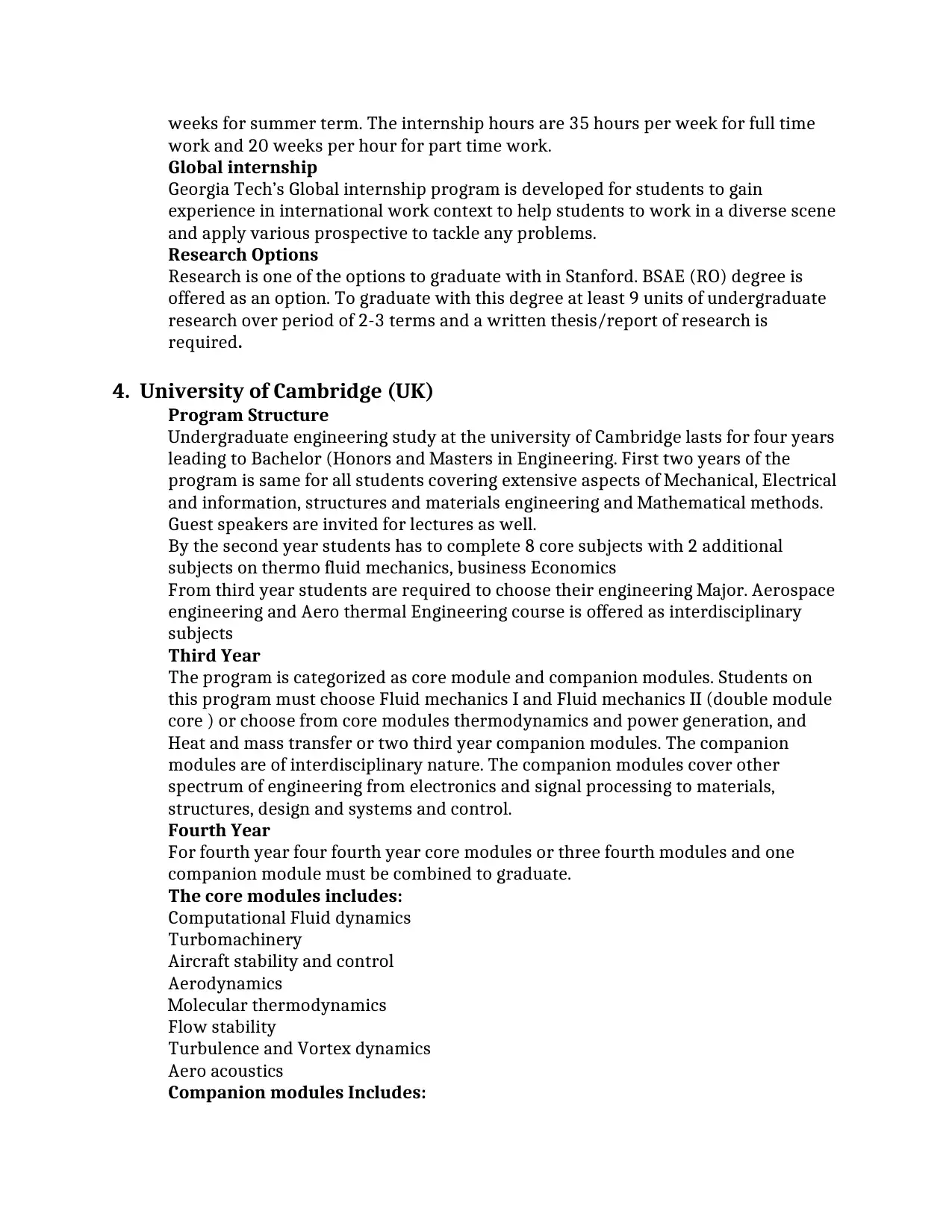
weeks for summer term. The internship hours are 35 hours per week for full time
work and 20 weeks per hour for part time work.
Global internship
Georgia Tech’s Global internship program is developed for students to gain
experience in international work context to help students to work in a diverse scene
and apply various prospective to tackle any problems.
Research Options
Research is one of the options to graduate with in Stanford. BSAE (RO) degree is
offered as an option. To graduate with this degree at least 9 units of undergraduate
research over period of 2-3 terms and a written thesis/report of research is
required.
4. University of Cambridge (UK)
Program Structure
Undergraduate engineering study at the university of Cambridge lasts for four years
leading to Bachelor (Honors and Masters in Engineering. First two years of the
program is same for all students covering extensive aspects of Mechanical, Electrical
and information, structures and materials engineering and Mathematical methods.
Guest speakers are invited for lectures as well.
By the second year students has to complete 8 core subjects with 2 additional
subjects on thermo fluid mechanics, business Economics
From third year students are required to choose their engineering Major. Aerospace
engineering and Aero thermal Engineering course is offered as interdisciplinary
subjects
Third Year
The program is categorized as core module and companion modules. Students on
this program must choose Fluid mechanics I and Fluid mechanics II (double module
core ) or choose from core modules thermodynamics and power generation, and
Heat and mass transfer or two third year companion modules. The companion
modules are of interdisciplinary nature. The companion modules cover other
spectrum of engineering from electronics and signal processing to materials,
structures, design and systems and control.
Fourth Year
For fourth year four fourth year core modules or three fourth modules and one
companion module must be combined to graduate.
The core modules includes:
Computational Fluid dynamics
Turbomachinery
Aircraft stability and control
Aerodynamics
Molecular thermodynamics
Flow stability
Turbulence and Vortex dynamics
Aero acoustics
Companion modules Includes:
work and 20 weeks per hour for part time work.
Global internship
Georgia Tech’s Global internship program is developed for students to gain
experience in international work context to help students to work in a diverse scene
and apply various prospective to tackle any problems.
Research Options
Research is one of the options to graduate with in Stanford. BSAE (RO) degree is
offered as an option. To graduate with this degree at least 9 units of undergraduate
research over period of 2-3 terms and a written thesis/report of research is
required.
4. University of Cambridge (UK)
Program Structure
Undergraduate engineering study at the university of Cambridge lasts for four years
leading to Bachelor (Honors and Masters in Engineering. First two years of the
program is same for all students covering extensive aspects of Mechanical, Electrical
and information, structures and materials engineering and Mathematical methods.
Guest speakers are invited for lectures as well.
By the second year students has to complete 8 core subjects with 2 additional
subjects on thermo fluid mechanics, business Economics
From third year students are required to choose their engineering Major. Aerospace
engineering and Aero thermal Engineering course is offered as interdisciplinary
subjects
Third Year
The program is categorized as core module and companion modules. Students on
this program must choose Fluid mechanics I and Fluid mechanics II (double module
core ) or choose from core modules thermodynamics and power generation, and
Heat and mass transfer or two third year companion modules. The companion
modules are of interdisciplinary nature. The companion modules cover other
spectrum of engineering from electronics and signal processing to materials,
structures, design and systems and control.
Fourth Year
For fourth year four fourth year core modules or three fourth modules and one
companion module must be combined to graduate.
The core modules includes:
Computational Fluid dynamics
Turbomachinery
Aircraft stability and control
Aerodynamics
Molecular thermodynamics
Flow stability
Turbulence and Vortex dynamics
Aero acoustics
Companion modules Includes:

Electronic sensors and instrumentation
Designing with composites
Design methods
Design case studies
Advanced linear vibration
Random and non-linear vibrations
Continuum mechanics
MEMS: design
Control system design
Robust and non linear system design
Optimum and predictive control
Research
The university offers research project within the department as well as collaborate
with successful university and industry.
SAMIA
Sir Arthur Marshall Institute of Aeronautics is a collaboration between Marshall
Aerospace based in Cambridge with the department of Engineering.
University Technology Partnership (UTP)
This research program is partnership with BAE/Rolls Royce Technology
university.for Design. The university along with other academics has already
successfully conducted research on behalf of the partner companies
The University Gas Turbine Partnership(UGTP)
This is Cambridge Based turbine research centre in partnership with Rolls Royce
and supports turbomachinary research in university.
5. Imperial college of London (United Kingdom)
Program structure
Undergraduate program at Imperial College is integrated with Masters Degree. Four
courses are available to choose among:
MEng in Aeronautical Engineering
MEng in Aeronautical Engineering with a year abroad
MEng in Aeronautical Engineering with industry
MEng in Aeronautics with Spacecraft Engineering
The first two years of the program is same with other undergraduate program that
includes Mathematics, computer Programming and design as well as computational
and experimental projects however year two is more specialized in aeronautics
subjects like aerodynamics, flight mechanics and propulsion and turbomachinary
and flight testing course at National Laboratory center at Cranfield University.
In year three students undertake design group project on a feasible design concept.
For MEng Aeronautical engineering with year abroad program university offer
exchange program with similar program at approved university in Ecole Centrle de
Lyon in France, Germany, National University of Singapore, ETH Zurich of
Switzerland, MIT in USA or University of California IN USA.
Designing with composites
Design methods
Design case studies
Advanced linear vibration
Random and non-linear vibrations
Continuum mechanics
MEMS: design
Control system design
Robust and non linear system design
Optimum and predictive control
Research
The university offers research project within the department as well as collaborate
with successful university and industry.
SAMIA
Sir Arthur Marshall Institute of Aeronautics is a collaboration between Marshall
Aerospace based in Cambridge with the department of Engineering.
University Technology Partnership (UTP)
This research program is partnership with BAE/Rolls Royce Technology
university.for Design. The university along with other academics has already
successfully conducted research on behalf of the partner companies
The University Gas Turbine Partnership(UGTP)
This is Cambridge Based turbine research centre in partnership with Rolls Royce
and supports turbomachinary research in university.
5. Imperial college of London (United Kingdom)
Program structure
Undergraduate program at Imperial College is integrated with Masters Degree. Four
courses are available to choose among:
MEng in Aeronautical Engineering
MEng in Aeronautical Engineering with a year abroad
MEng in Aeronautical Engineering with industry
MEng in Aeronautics with Spacecraft Engineering
The first two years of the program is same with other undergraduate program that
includes Mathematics, computer Programming and design as well as computational
and experimental projects however year two is more specialized in aeronautics
subjects like aerodynamics, flight mechanics and propulsion and turbomachinary
and flight testing course at National Laboratory center at Cranfield University.
In year three students undertake design group project on a feasible design concept.
For MEng Aeronautical engineering with year abroad program university offer
exchange program with similar program at approved university in Ecole Centrle de
Lyon in France, Germany, National University of Singapore, ETH Zurich of
Switzerland, MIT in USA or University of California IN USA.
Paraphrase This Document
Need a fresh take? Get an instant paraphrase of this document with our AI Paraphraser

During fourth year students reach Master’s level with advanced study modules and
four month individual research under supervision of both college and industrial
supervisors.
For MEng in Aeronautics with Spacecraft Engineering advanced space-related
modules are introduced and broad modules for optional subjects. Students in this
course enter research project that are related to space for four month.
Students of MEng Aeronautical engineer with industry have to complete industrial
placement between third and fourth year. The department also helps students in
organizing placement.
6. Tsinghua University (China)
Program structure
Undergraduate degree in Tsinghua university lasts for 4 years. First three years of
the course has broad range of subjects from courses on Mathematics, Physics,
Chemistry, Mechanics , Humanities and social sciences. Only in the fourth students
choose their major in Engineering.
Curriculum
Their curriculum consists of eight modules.
Humanities and Social Science
Mathematics
Advanced Calculus
Advanced Algebra and Geometry
Ordinary Differential Equation
Probability and Statistics
Method of Mathematical Physics
Natural Science
Physics,
Chemistry,
Introduction to Cellular and Molecular Biology,
Introduction to Information Sciences,
Introduction to Materials Science and Engineering
Computational Science and Engineering
Computer Architecture and Programming
Numerical Methods in Engineering
Computational Solid Mechanics
Computational Fluid Mechanics
Mechanics
Theoretical Mechanics,
Mechanics of Materials,
Theory of Elasticity, Fluid Mechanics
Mechanics of Vibration,
Statistical Mechanics
Thermodynamics
Experimental and Subject Module for Mechanics and Modern Engineering
Mechanical Design
four month individual research under supervision of both college and industrial
supervisors.
For MEng in Aeronautics with Spacecraft Engineering advanced space-related
modules are introduced and broad modules for optional subjects. Students in this
course enter research project that are related to space for four month.
Students of MEng Aeronautical engineer with industry have to complete industrial
placement between third and fourth year. The department also helps students in
organizing placement.
6. Tsinghua University (China)
Program structure
Undergraduate degree in Tsinghua university lasts for 4 years. First three years of
the course has broad range of subjects from courses on Mathematics, Physics,
Chemistry, Mechanics , Humanities and social sciences. Only in the fourth students
choose their major in Engineering.
Curriculum
Their curriculum consists of eight modules.
Humanities and Social Science
Mathematics
Advanced Calculus
Advanced Algebra and Geometry
Ordinary Differential Equation
Probability and Statistics
Method of Mathematical Physics
Natural Science
Physics,
Chemistry,
Introduction to Cellular and Molecular Biology,
Introduction to Information Sciences,
Introduction to Materials Science and Engineering
Computational Science and Engineering
Computer Architecture and Programming
Numerical Methods in Engineering
Computational Solid Mechanics
Computational Fluid Mechanics
Mechanics
Theoretical Mechanics,
Mechanics of Materials,
Theory of Elasticity, Fluid Mechanics
Mechanics of Vibration,
Statistical Mechanics
Thermodynamics
Experimental and Subject Module for Mechanics and Modern Engineering
Mechanical Design

Electronics in Electric Engineering
Experiment in Solid Mechanics
Three General Projects
Comprehensive Research
Research Paper
Advanced Optional
Students choose one optional module from various majors for Aerospace
Engineer they choose the aerospace engineering module as their Major
7. Peking University (China)
The undergraduate program in Peking University is fairly new started in 2008.
It offers courses in Theoretical Physics, theory of elasticity and fluid mechanics and
invited lectures from industry experts and recognized scholars about the current
technology and progress in aeronautics and astronautics. The university also
organizes tours, internship offers and research in key industries for hands
experience. Students are also exposed to global design courses, where they form a
group under supervision of Professor and technical manager from company to solve
practical problem raised by aerospace companies.
8. Delft University of Technology (Netherlands)
Delft university of Technology offers three years Bachelors of Science on Aerospace
engineering full time on campus. Students are introduced to field of aerospace with
a series of introductory classes along with other engineering classes such as
mathematics, mechanics and the course starts to grow from there. Students in this
program have to undergo large numbers of group projects as well.
Program structure
The first year of this program introduces students to specifies of aerospace
engineering and design projects
Second year students learn about system design processing and measurement data
and the topics from first year discussed in depth. Two wind tunnel practical classes
are integrated in second year program.
During the third year first semester minor program can be studied at the university
or other universities in Netherlands or at partner universities abroad. Design
synthesis course is designed for second semester where students work with group
of students on relevant and original design project authorized by aerospace
industries or research organizations.
Curriculum
Each day of lecture starts at 8:45 and Ends at 5:30 however attendance is not
compulsory but laboratory classes requires attendance. Each year is divided into 4
quarter.
First year Course
First 2 quarter is Exploring Aerospace Engineering and classes are:
Engineering Drawing, Introduction to Aerospace Engineering I and II, Aerospace
Materials, Statics, Dynamics, Calculus I.a and I.b
Third and 4th quarter is Design and Construction and Class are Technical writing,
Aerospace Design and system Engineering I, Aerospace Mechanics of Materials,
Experiment in Solid Mechanics
Three General Projects
Comprehensive Research
Research Paper
Advanced Optional
Students choose one optional module from various majors for Aerospace
Engineer they choose the aerospace engineering module as their Major
7. Peking University (China)
The undergraduate program in Peking University is fairly new started in 2008.
It offers courses in Theoretical Physics, theory of elasticity and fluid mechanics and
invited lectures from industry experts and recognized scholars about the current
technology and progress in aeronautics and astronautics. The university also
organizes tours, internship offers and research in key industries for hands
experience. Students are also exposed to global design courses, where they form a
group under supervision of Professor and technical manager from company to solve
practical problem raised by aerospace companies.
8. Delft University of Technology (Netherlands)
Delft university of Technology offers three years Bachelors of Science on Aerospace
engineering full time on campus. Students are introduced to field of aerospace with
a series of introductory classes along with other engineering classes such as
mathematics, mechanics and the course starts to grow from there. Students in this
program have to undergo large numbers of group projects as well.
Program structure
The first year of this program introduces students to specifies of aerospace
engineering and design projects
Second year students learn about system design processing and measurement data
and the topics from first year discussed in depth. Two wind tunnel practical classes
are integrated in second year program.
During the third year first semester minor program can be studied at the university
or other universities in Netherlands or at partner universities abroad. Design
synthesis course is designed for second semester where students work with group
of students on relevant and original design project authorized by aerospace
industries or research organizations.
Curriculum
Each day of lecture starts at 8:45 and Ends at 5:30 however attendance is not
compulsory but laboratory classes requires attendance. Each year is divided into 4
quarter.
First year Course
First 2 quarter is Exploring Aerospace Engineering and classes are:
Engineering Drawing, Introduction to Aerospace Engineering I and II, Aerospace
Materials, Statics, Dynamics, Calculus I.a and I.b
Third and 4th quarter is Design and Construction and Class are Technical writing,
Aerospace Design and system Engineering I, Aerospace Mechanics of Materials,
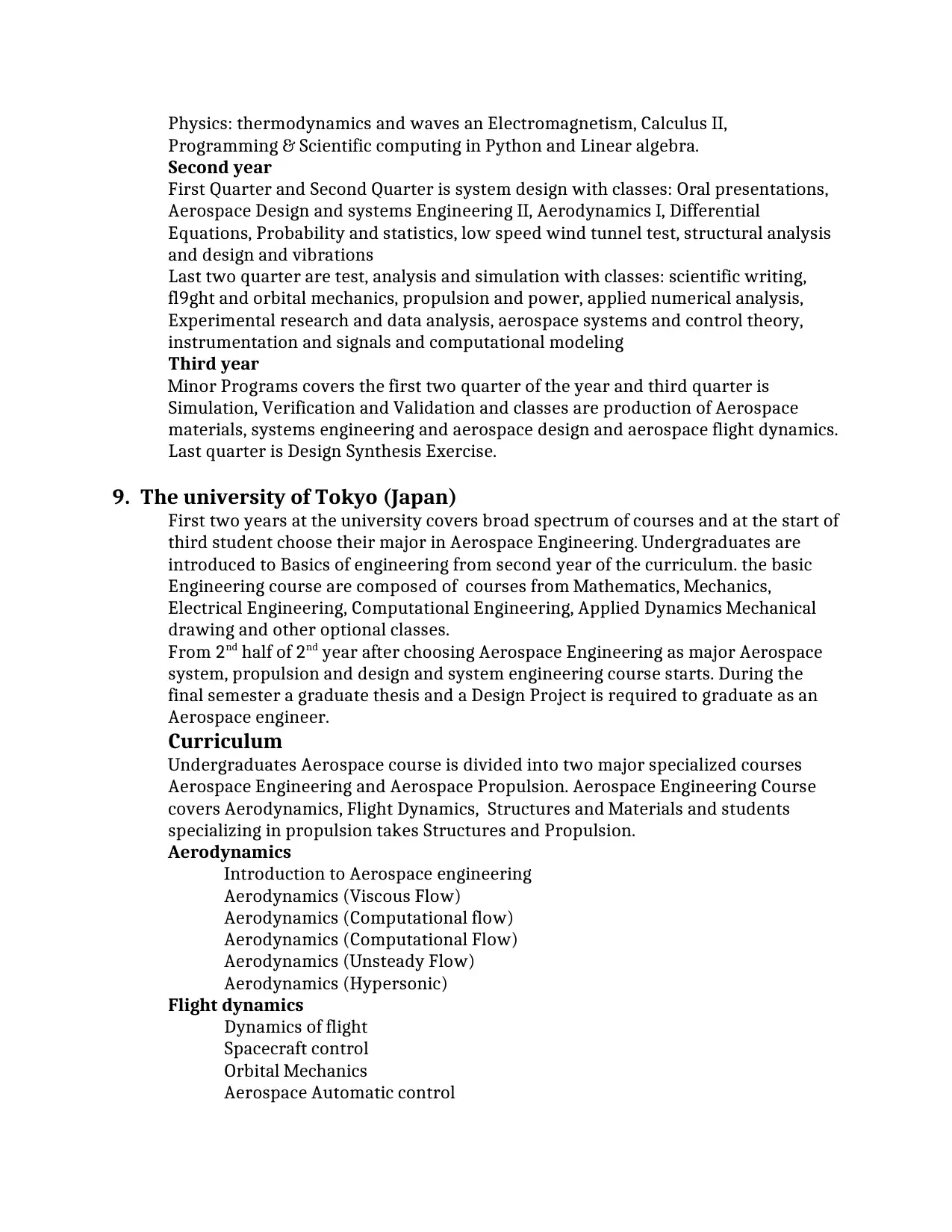
Physics: thermodynamics and waves an Electromagnetism, Calculus II,
Programming & Scientific computing in Python and Linear algebra.
Second year
First Quarter and Second Quarter is system design with classes: Oral presentations,
Aerospace Design and systems Engineering II, Aerodynamics I, Differential
Equations, Probability and statistics, low speed wind tunnel test, structural analysis
and design and vibrations
Last two quarter are test, analysis and simulation with classes: scientific writing,
fl9ght and orbital mechanics, propulsion and power, applied numerical analysis,
Experimental research and data analysis, aerospace systems and control theory,
instrumentation and signals and computational modeling
Third year
Minor Programs covers the first two quarter of the year and third quarter is
Simulation, Verification and Validation and classes are production of Aerospace
materials, systems engineering and aerospace design and aerospace flight dynamics.
Last quarter is Design Synthesis Exercise.
9. The university of Tokyo (Japan)
First two years at the university covers broad spectrum of courses and at the start of
third student choose their major in Aerospace Engineering. Undergraduates are
introduced to Basics of engineering from second year of the curriculum. the basic
Engineering course are composed of courses from Mathematics, Mechanics,
Electrical Engineering, Computational Engineering, Applied Dynamics Mechanical
drawing and other optional classes.
From 2nd half of 2nd year after choosing Aerospace Engineering as major Aerospace
system, propulsion and design and system engineering course starts. During the
final semester a graduate thesis and a Design Project is required to graduate as an
Aerospace engineer.
Curriculum
Undergraduates Aerospace course is divided into two major specialized courses
Aerospace Engineering and Aerospace Propulsion. Aerospace Engineering Course
covers Aerodynamics, Flight Dynamics, Structures and Materials and students
specializing in propulsion takes Structures and Propulsion.
Aerodynamics
Introduction to Aerospace engineering
Aerodynamics (Viscous Flow)
Aerodynamics (Computational flow)
Aerodynamics (Computational Flow)
Aerodynamics (Unsteady Flow)
Aerodynamics (Hypersonic)
Flight dynamics
Dynamics of flight
Spacecraft control
Orbital Mechanics
Aerospace Automatic control
Programming & Scientific computing in Python and Linear algebra.
Second year
First Quarter and Second Quarter is system design with classes: Oral presentations,
Aerospace Design and systems Engineering II, Aerodynamics I, Differential
Equations, Probability and statistics, low speed wind tunnel test, structural analysis
and design and vibrations
Last two quarter are test, analysis and simulation with classes: scientific writing,
fl9ght and orbital mechanics, propulsion and power, applied numerical analysis,
Experimental research and data analysis, aerospace systems and control theory,
instrumentation and signals and computational modeling
Third year
Minor Programs covers the first two quarter of the year and third quarter is
Simulation, Verification and Validation and classes are production of Aerospace
materials, systems engineering and aerospace design and aerospace flight dynamics.
Last quarter is Design Synthesis Exercise.
9. The university of Tokyo (Japan)
First two years at the university covers broad spectrum of courses and at the start of
third student choose their major in Aerospace Engineering. Undergraduates are
introduced to Basics of engineering from second year of the curriculum. the basic
Engineering course are composed of courses from Mathematics, Mechanics,
Electrical Engineering, Computational Engineering, Applied Dynamics Mechanical
drawing and other optional classes.
From 2nd half of 2nd year after choosing Aerospace Engineering as major Aerospace
system, propulsion and design and system engineering course starts. During the
final semester a graduate thesis and a Design Project is required to graduate as an
Aerospace engineer.
Curriculum
Undergraduates Aerospace course is divided into two major specialized courses
Aerospace Engineering and Aerospace Propulsion. Aerospace Engineering Course
covers Aerodynamics, Flight Dynamics, Structures and Materials and students
specializing in propulsion takes Structures and Propulsion.
Aerodynamics
Introduction to Aerospace engineering
Aerodynamics (Viscous Flow)
Aerodynamics (Computational flow)
Aerodynamics (Computational Flow)
Aerodynamics (Unsteady Flow)
Aerodynamics (Hypersonic)
Flight dynamics
Dynamics of flight
Spacecraft control
Orbital Mechanics
Aerospace Automatic control
Secure Best Marks with AI Grader
Need help grading? Try our AI Grader for instant feedback on your assignments.
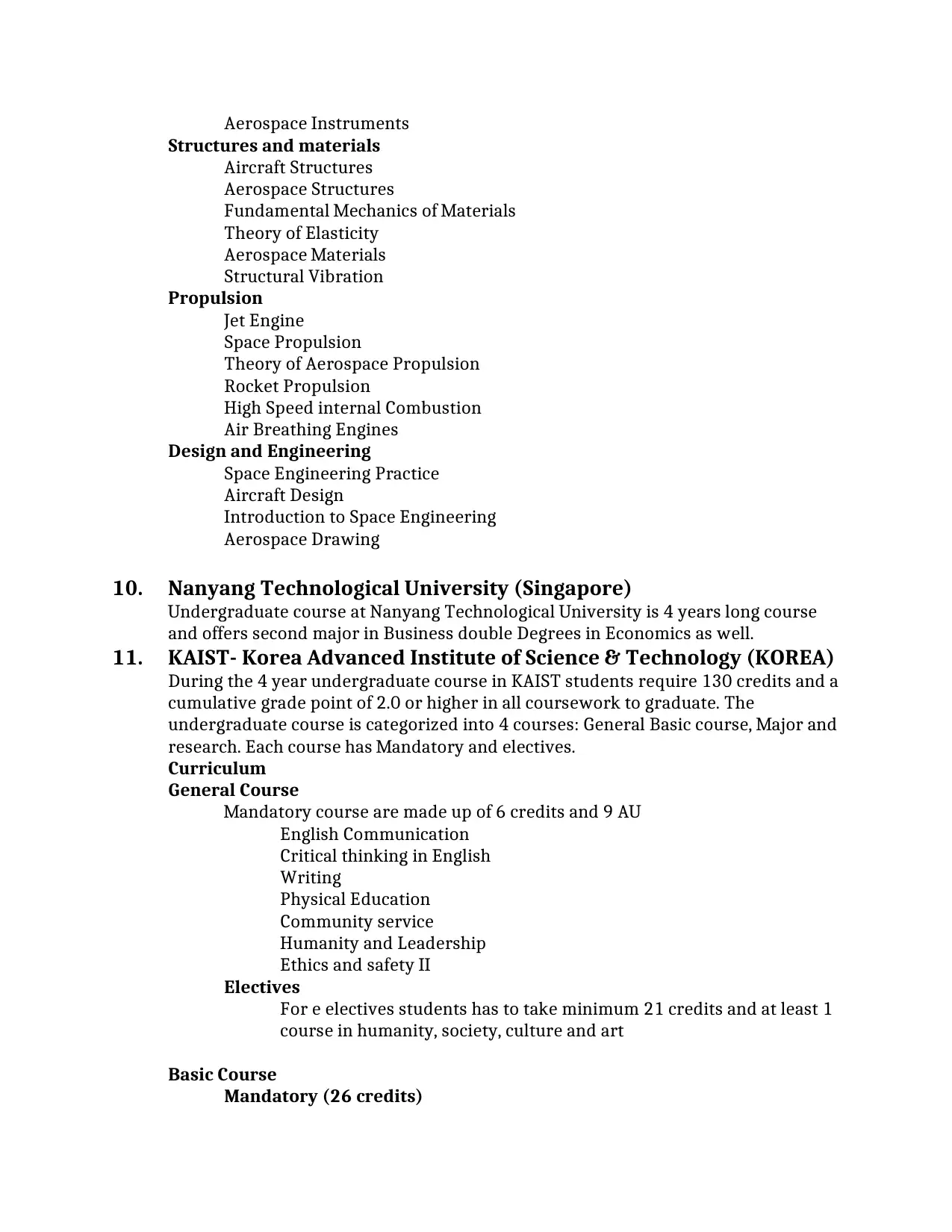
Aerospace Instruments
Structures and materials
Aircraft Structures
Aerospace Structures
Fundamental Mechanics of Materials
Theory of Elasticity
Aerospace Materials
Structural Vibration
Propulsion
Jet Engine
Space Propulsion
Theory of Aerospace Propulsion
Rocket Propulsion
High Speed internal Combustion
Air Breathing Engines
Design and Engineering
Space Engineering Practice
Aircraft Design
Introduction to Space Engineering
Aerospace Drawing
10. Nanyang Technological University (Singapore)
Undergraduate course at Nanyang Technological University is 4 years long course
and offers second major in Business double Degrees in Economics as well.
11. KAIST- Korea Advanced Institute of Science & Technology (KOREA)
During the 4 year undergraduate course in KAIST students require 130 credits and a
cumulative grade point of 2.0 or higher in all coursework to graduate. The
undergraduate course is categorized into 4 courses: General Basic course, Major and
research. Each course has Mandatory and electives.
Curriculum
General Course
Mandatory course are made up of 6 credits and 9 AU
English Communication
Critical thinking in English
Writing
Physical Education
Community service
Humanity and Leadership
Ethics and safety II
Electives
For e electives students has to take minimum 21 credits and at least 1
course in humanity, society, culture and art
Basic Course
Mandatory (26 credits)
Structures and materials
Aircraft Structures
Aerospace Structures
Fundamental Mechanics of Materials
Theory of Elasticity
Aerospace Materials
Structural Vibration
Propulsion
Jet Engine
Space Propulsion
Theory of Aerospace Propulsion
Rocket Propulsion
High Speed internal Combustion
Air Breathing Engines
Design and Engineering
Space Engineering Practice
Aircraft Design
Introduction to Space Engineering
Aerospace Drawing
10. Nanyang Technological University (Singapore)
Undergraduate course at Nanyang Technological University is 4 years long course
and offers second major in Business double Degrees in Economics as well.
11. KAIST- Korea Advanced Institute of Science & Technology (KOREA)
During the 4 year undergraduate course in KAIST students require 130 credits and a
cumulative grade point of 2.0 or higher in all coursework to graduate. The
undergraduate course is categorized into 4 courses: General Basic course, Major and
research. Each course has Mandatory and electives.
Curriculum
General Course
Mandatory course are made up of 6 credits and 9 AU
English Communication
Critical thinking in English
Writing
Physical Education
Community service
Humanity and Leadership
Ethics and safety II
Electives
For e electives students has to take minimum 21 credits and at least 1
course in humanity, society, culture and art
Basic Course
Mandatory (26 credits)
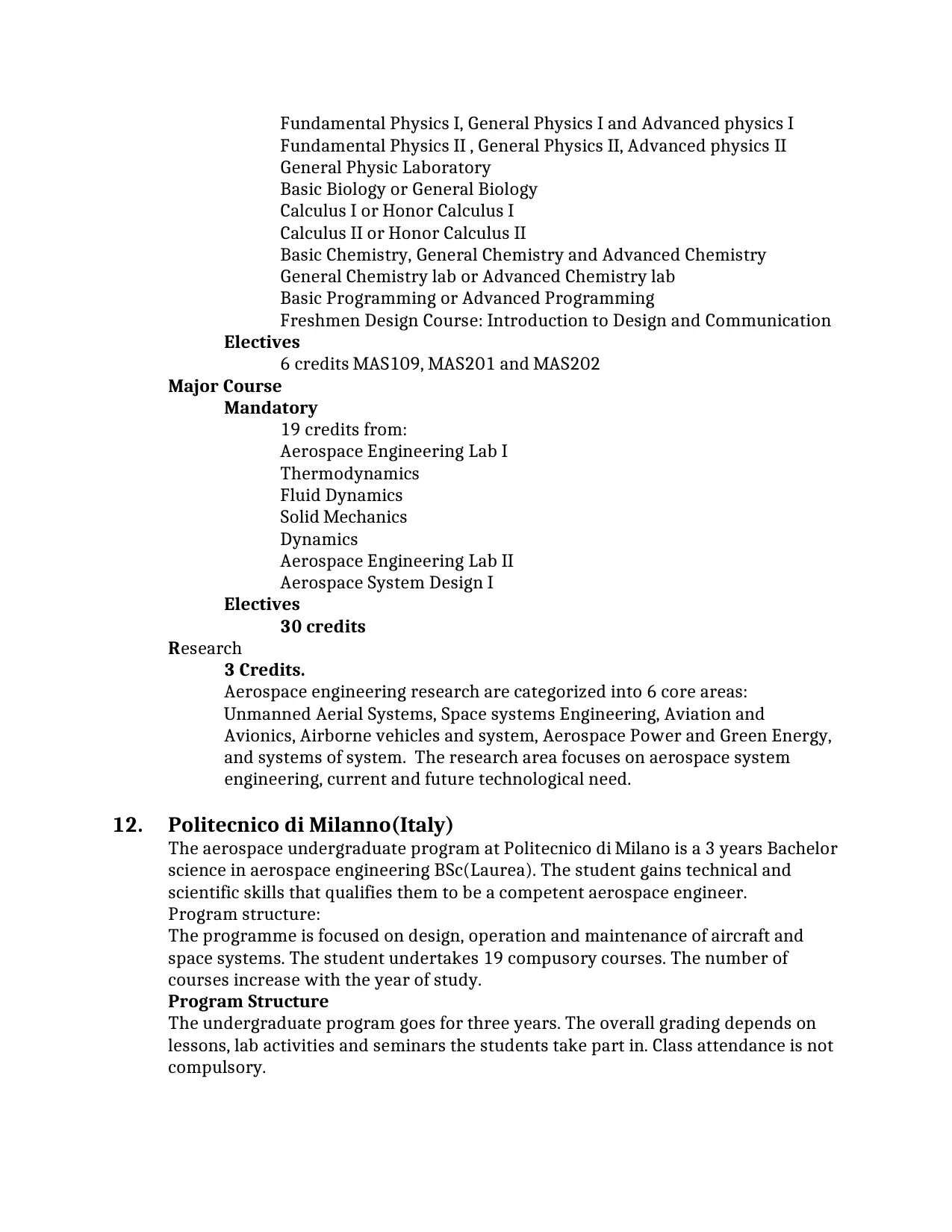
Fundamental Physics I, General Physics I and Advanced physics I
Fundamental Physics II , General Physics II, Advanced physics II
General Physic Laboratory
Basic Biology or General Biology
Calculus I or Honor Calculus I
Calculus II or Honor Calculus II
Basic Chemistry, General Chemistry and Advanced Chemistry
General Chemistry lab or Advanced Chemistry lab
Basic Programming or Advanced Programming
Freshmen Design Course: Introduction to Design and Communication
Electives
6 credits MAS109, MAS201 and MAS202
Major Course
Mandatory
19 credits from:
Aerospace Engineering Lab I
Thermodynamics
Fluid Dynamics
Solid Mechanics
Dynamics
Aerospace Engineering Lab II
Aerospace System Design I
Electives
30 credits
Research
3 Credits.
Aerospace engineering research are categorized into 6 core areas:
Unmanned Aerial Systems, Space systems Engineering, Aviation and
Avionics, Airborne vehicles and system, Aerospace Power and Green Energy,
and systems of system. The research area focuses on aerospace system
engineering, current and future technological need.
12. Politecnico di Milanno(Italy)
The aerospace undergraduate program at Politecnico di Milano is a 3 years Bachelor
science in aerospace engineering BSc(Laurea). The student gains technical and
scientific skills that qualifies them to be a competent aerospace engineer.
Program structure:
The programme is focused on design, operation and maintenance of aircraft and
space systems. The student undertakes 19 compusory courses. The number of
courses increase with the year of study.
Program Structure
The undergraduate program goes for three years. The overall grading depends on
lessons, lab activities and seminars the students take part in. Class attendance is not
compulsory.
Fundamental Physics II , General Physics II, Advanced physics II
General Physic Laboratory
Basic Biology or General Biology
Calculus I or Honor Calculus I
Calculus II or Honor Calculus II
Basic Chemistry, General Chemistry and Advanced Chemistry
General Chemistry lab or Advanced Chemistry lab
Basic Programming or Advanced Programming
Freshmen Design Course: Introduction to Design and Communication
Electives
6 credits MAS109, MAS201 and MAS202
Major Course
Mandatory
19 credits from:
Aerospace Engineering Lab I
Thermodynamics
Fluid Dynamics
Solid Mechanics
Dynamics
Aerospace Engineering Lab II
Aerospace System Design I
Electives
30 credits
Research
3 Credits.
Aerospace engineering research are categorized into 6 core areas:
Unmanned Aerial Systems, Space systems Engineering, Aviation and
Avionics, Airborne vehicles and system, Aerospace Power and Green Energy,
and systems of system. The research area focuses on aerospace system
engineering, current and future technological need.
12. Politecnico di Milanno(Italy)
The aerospace undergraduate program at Politecnico di Milano is a 3 years Bachelor
science in aerospace engineering BSc(Laurea). The student gains technical and
scientific skills that qualifies them to be a competent aerospace engineer.
Program structure:
The programme is focused on design, operation and maintenance of aircraft and
space systems. The student undertakes 19 compusory courses. The number of
courses increase with the year of study.
Program Structure
The undergraduate program goes for three years. The overall grading depends on
lessons, lab activities and seminars the students take part in. Class attendance is not
compulsory.
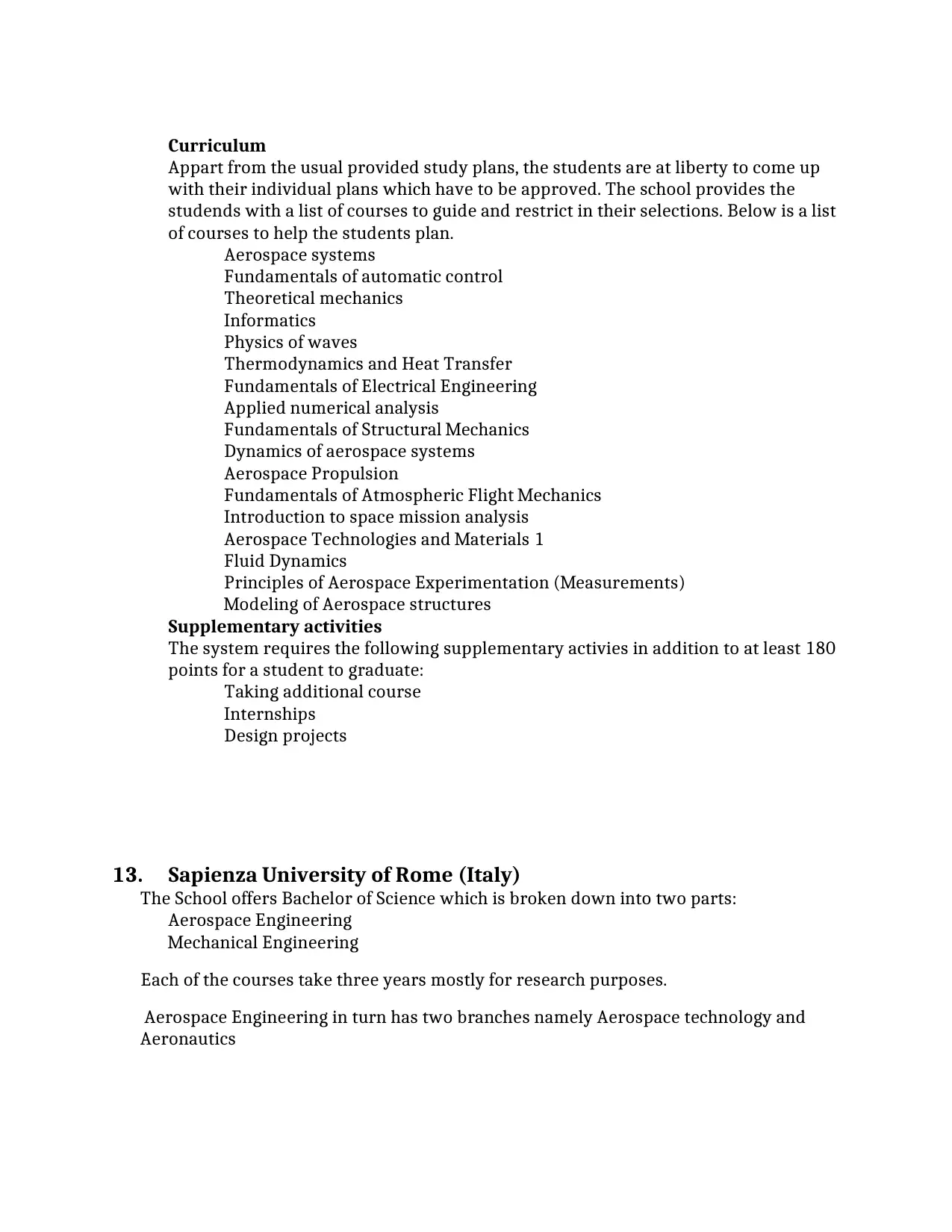
Curriculum
Appart from the usual provided study plans, the students are at liberty to come up
with their individual plans which have to be approved. The school provides the
studends with a list of courses to guide and restrict in their selections. Below is a list
of courses to help the students plan.
Aerospace systems
Fundamentals of automatic control
Theoretical mechanics
Informatics
Physics of waves
Thermodynamics and Heat Transfer
Fundamentals of Electrical Engineering
Applied numerical analysis
Fundamentals of Structural Mechanics
Dynamics of aerospace systems
Aerospace Propulsion
Fundamentals of Atmospheric Flight Mechanics
Introduction to space mission analysis
Aerospace Technologies and Materials 1
Fluid Dynamics
Principles of Aerospace Experimentation (Measurements)
Modeling of Aerospace structures
Supplementary activities
The system requires the following supplementary activies in addition to at least 180
points for a student to graduate:
Taking additional course
Internships
Design projects
13. Sapienza University of Rome (Italy)
The School offers Bachelor of Science which is broken down into two parts:
Aerospace Engineering
Mechanical Engineering
Each of the courses take three years mostly for research purposes.
Aerospace Engineering in turn has two branches namely Aerospace technology and
Aeronautics
Appart from the usual provided study plans, the students are at liberty to come up
with their individual plans which have to be approved. The school provides the
studends with a list of courses to guide and restrict in their selections. Below is a list
of courses to help the students plan.
Aerospace systems
Fundamentals of automatic control
Theoretical mechanics
Informatics
Physics of waves
Thermodynamics and Heat Transfer
Fundamentals of Electrical Engineering
Applied numerical analysis
Fundamentals of Structural Mechanics
Dynamics of aerospace systems
Aerospace Propulsion
Fundamentals of Atmospheric Flight Mechanics
Introduction to space mission analysis
Aerospace Technologies and Materials 1
Fluid Dynamics
Principles of Aerospace Experimentation (Measurements)
Modeling of Aerospace structures
Supplementary activities
The system requires the following supplementary activies in addition to at least 180
points for a student to graduate:
Taking additional course
Internships
Design projects
13. Sapienza University of Rome (Italy)
The School offers Bachelor of Science which is broken down into two parts:
Aerospace Engineering
Mechanical Engineering
Each of the courses take three years mostly for research purposes.
Aerospace Engineering in turn has two branches namely Aerospace technology and
Aeronautics
Paraphrase This Document
Need a fresh take? Get an instant paraphrase of this document with our AI Paraphraser
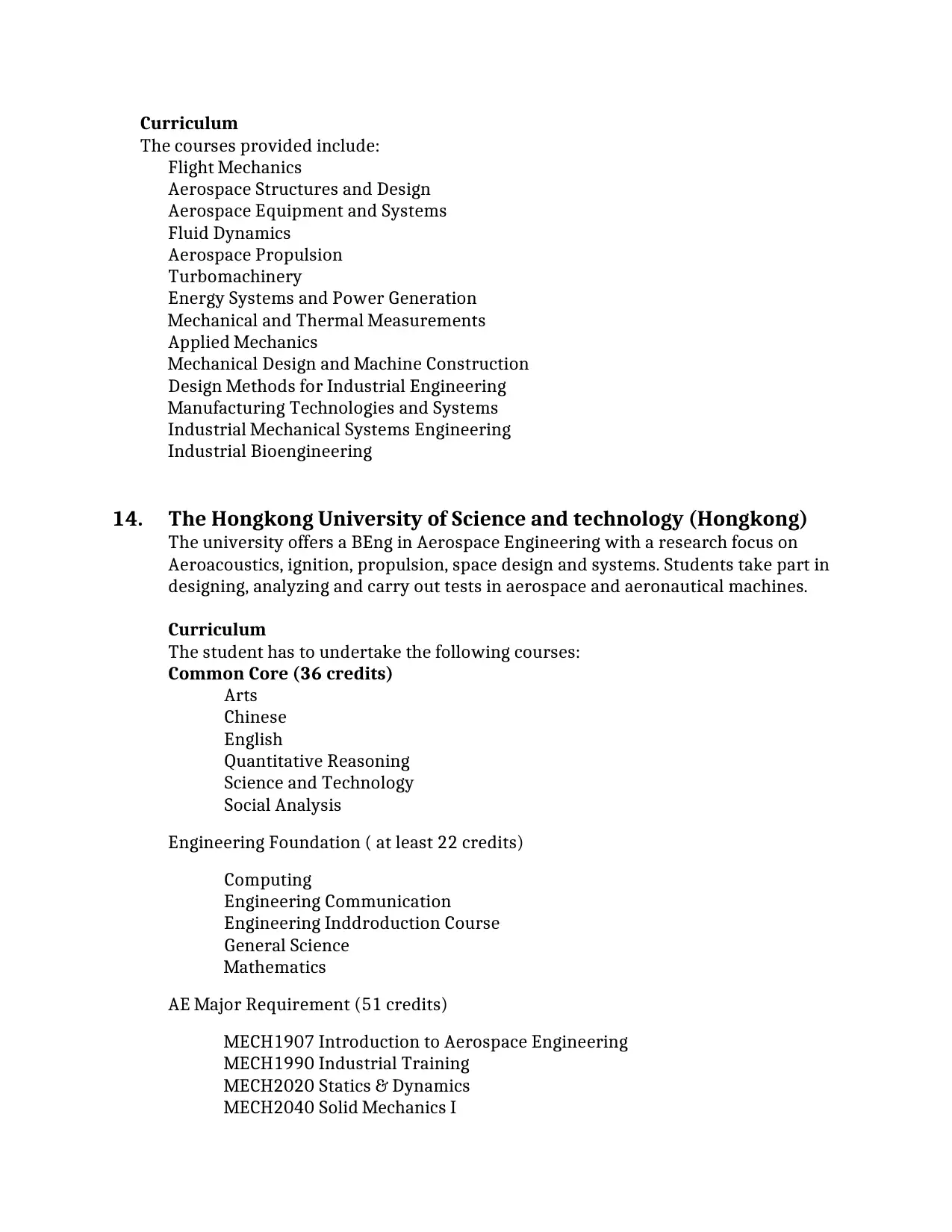
Curriculum
The courses provided include:
Flight Mechanics
Aerospace Structures and Design
Aerospace Equipment and Systems
Fluid Dynamics
Aerospace Propulsion
Turbomachinery
Energy Systems and Power Generation
Mechanical and Thermal Measurements
Applied Mechanics
Mechanical Design and Machine Construction
Design Methods for Industrial Engineering
Manufacturing Technologies and Systems
Industrial Mechanical Systems Engineering
Industrial Bioengineering
14. The Hongkong University of Science and technology (Hongkong)
The university offers a BEng in Aerospace Engineering with a research focus on
Aeroacoustics, ignition, propulsion, space design and systems. Students take part in
designing, analyzing and carry out tests in aerospace and aeronautical machines.
Curriculum
The student has to undertake the following courses:
Common Core (36 credits)
Arts
Chinese
English
Quantitative Reasoning
Science and Technology
Social Analysis
Engineering Foundation ( at least 22 credits)
Computing
Engineering Communication
Engineering Inddroduction Course
General Science
Mathematics
AE Major Requirement (51 credits)
MECH1907 Introduction to Aerospace Engineering
MECH1990 Industrial Training
MECH2020 Statics & Dynamics
MECH2040 Solid Mechanics I
The courses provided include:
Flight Mechanics
Aerospace Structures and Design
Aerospace Equipment and Systems
Fluid Dynamics
Aerospace Propulsion
Turbomachinery
Energy Systems and Power Generation
Mechanical and Thermal Measurements
Applied Mechanics
Mechanical Design and Machine Construction
Design Methods for Industrial Engineering
Manufacturing Technologies and Systems
Industrial Mechanical Systems Engineering
Industrial Bioengineering
14. The Hongkong University of Science and technology (Hongkong)
The university offers a BEng in Aerospace Engineering with a research focus on
Aeroacoustics, ignition, propulsion, space design and systems. Students take part in
designing, analyzing and carry out tests in aerospace and aeronautical machines.
Curriculum
The student has to undertake the following courses:
Common Core (36 credits)
Arts
Chinese
English
Quantitative Reasoning
Science and Technology
Social Analysis
Engineering Foundation ( at least 22 credits)
Computing
Engineering Communication
Engineering Inddroduction Course
General Science
Mathematics
AE Major Requirement (51 credits)
MECH1907 Introduction to Aerospace Engineering
MECH1990 Industrial Training
MECH2020 Statics & Dynamics
MECH2040 Solid Mechanics I

MECH2210 Fluid Mechanics
MECH2310 Thermodynamics
MECH2410 Engineering Materials I
MECH3610 Control Principles
MECH3620 Aircraft Design
MECH3640 Aerodynamics
MECH3650 Aircraft Structure
MECH3660 Gas Turbines and Jet Propulsion
MECH3670 Aircraft Performance and Stability
MECH3690 Aerospace Engineering Laboratory
MECH4980 Final Year Aerospace Design Project
ELEC2420 Basic Electronics
ENGG2010 Engineering Seminar Series
LANG4034 Technical Communication II
AE Elective Courses (12 credits)
MECH2520 Design and Manufacturing I
MECH3310 Heat Transfer
MECH3680 Avionics Systems
MECH4100 Experiential Projects in Aerospace Engineering
MECH4810 Unmanned Aviation Vehicle
MECH4820 Flight Mechanics
MECH4830 Aviation Systems and Logistics
MECH4840 Air Traffic Control/ Management
MECH4850 Vibration and Acoustics
MECH4860 Aeroelasticity
MECH4870 Computational Fluid Dynamics (CFD)
MECH4880 Combustion
Option (6 credits)
MECH4990 Aerospace Research Project
15. MCGill University (Canada)
The university offers a training program for aerospace research and knowledge. The
research area majorly includes aerospace law. Students undertaking Mechanical
Engineering can also do Aeronautical Engineering.
Program structure
The program takes 2 years.
Curriculum
MECH2310 Thermodynamics
MECH2410 Engineering Materials I
MECH3610 Control Principles
MECH3620 Aircraft Design
MECH3640 Aerodynamics
MECH3650 Aircraft Structure
MECH3660 Gas Turbines and Jet Propulsion
MECH3670 Aircraft Performance and Stability
MECH3690 Aerospace Engineering Laboratory
MECH4980 Final Year Aerospace Design Project
ELEC2420 Basic Electronics
ENGG2010 Engineering Seminar Series
LANG4034 Technical Communication II
AE Elective Courses (12 credits)
MECH2520 Design and Manufacturing I
MECH3310 Heat Transfer
MECH3680 Avionics Systems
MECH4100 Experiential Projects in Aerospace Engineering
MECH4810 Unmanned Aviation Vehicle
MECH4820 Flight Mechanics
MECH4830 Aviation Systems and Logistics
MECH4840 Air Traffic Control/ Management
MECH4850 Vibration and Acoustics
MECH4860 Aeroelasticity
MECH4870 Computational Fluid Dynamics (CFD)
MECH4880 Combustion
Option (6 credits)
MECH4990 Aerospace Research Project
15. MCGill University (Canada)
The university offers a training program for aerospace research and knowledge. The
research area majorly includes aerospace law. Students undertaking Mechanical
Engineering can also do Aeronautical Engineering.
Program structure
The program takes 2 years.
Curriculum
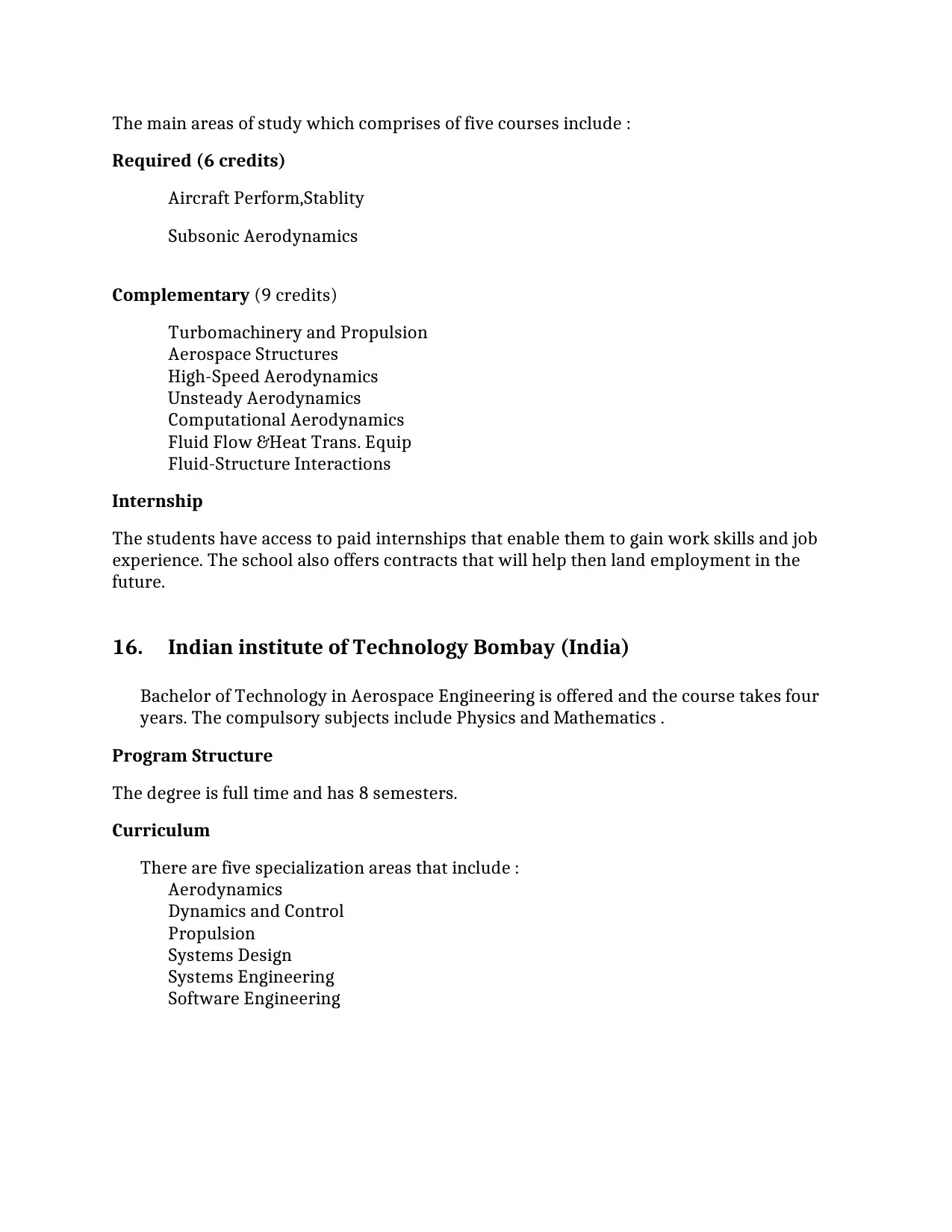
The main areas of study which comprises of five courses include :
Required (6 credits)
Aircraft Perform,Stablity
Subsonic Aerodynamics
Complementary (9 credits)
Turbomachinery and Propulsion
Aerospace Structures
High-Speed Aerodynamics
Unsteady Aerodynamics
Computational Aerodynamics
Fluid Flow &Heat Trans. Equip
Fluid-Structure Interactions
Internship
The students have access to paid internships that enable them to gain work skills and job
experience. The school also offers contracts that will help then land employment in the
future.
16. Indian institute of Technology Bombay (India)
Bachelor of Technology in Aerospace Engineering is offered and the course takes four
years. The compulsory subjects include Physics and Mathematics .
Program Structure
The degree is full time and has 8 semesters.
Curriculum
There are five specialization areas that include :
Aerodynamics
Dynamics and Control
Propulsion
Systems Design
Systems Engineering
Software Engineering
Required (6 credits)
Aircraft Perform,Stablity
Subsonic Aerodynamics
Complementary (9 credits)
Turbomachinery and Propulsion
Aerospace Structures
High-Speed Aerodynamics
Unsteady Aerodynamics
Computational Aerodynamics
Fluid Flow &Heat Trans. Equip
Fluid-Structure Interactions
Internship
The students have access to paid internships that enable them to gain work skills and job
experience. The school also offers contracts that will help then land employment in the
future.
16. Indian institute of Technology Bombay (India)
Bachelor of Technology in Aerospace Engineering is offered and the course takes four
years. The compulsory subjects include Physics and Mathematics .
Program Structure
The degree is full time and has 8 semesters.
Curriculum
There are five specialization areas that include :
Aerodynamics
Dynamics and Control
Propulsion
Systems Design
Systems Engineering
Software Engineering
Secure Best Marks with AI Grader
Need help grading? Try our AI Grader for instant feedback on your assignments.

17. Indian institute of Technology Madras (India)
Program Structure
The course goes for four years which constitute of 8 semester. The students are
required to deliver a project in their 7th and 8th semesters.
Curriculum
The topics covered by the students for this program include:
Fluid dynamics
Vortex methods of fluid flow analysis
Large-eddy simulation of turbulence
Transonic and oscillatory flows
Jet mixing and impingement
Fuel injection strategies
Low-density flows
Shock waves and hypervelocity flows
Acoustic waves and their propagation
Combustion and combustion instabilities
Supersonic combustion
Optical flow and combustion diagnostics
Solid propellant combustion
Nano-aluminium production & combustion
Structural Mechanics and analysis
Analysis of plates and shells
Composite structures
Fatigue and fracture mechanics
Fretting fatigue
Contact mechanics
18. Polytechnic university of Madrid (Spain)
Degree in Aerospace Engineering vomprises of five fields namely:
Aerospace vehicles
Propulsion
Airports and Air Transport
Aerospace Navigation Systems
Aerospace Sciences and Technologies.
Program Structure
The degree takes 8 semesters to complete.
19. Technion-Isreal Institute of Technology (Isreal)
The undergraduate program provides students with basic engineering skills as they
also develop professional skills.
Program Structure
The course goes for four years which constitute of 8 semester. The students are
required to deliver a project in their 7th and 8th semesters.
Curriculum
The topics covered by the students for this program include:
Fluid dynamics
Vortex methods of fluid flow analysis
Large-eddy simulation of turbulence
Transonic and oscillatory flows
Jet mixing and impingement
Fuel injection strategies
Low-density flows
Shock waves and hypervelocity flows
Acoustic waves and their propagation
Combustion and combustion instabilities
Supersonic combustion
Optical flow and combustion diagnostics
Solid propellant combustion
Nano-aluminium production & combustion
Structural Mechanics and analysis
Analysis of plates and shells
Composite structures
Fatigue and fracture mechanics
Fretting fatigue
Contact mechanics
18. Polytechnic university of Madrid (Spain)
Degree in Aerospace Engineering vomprises of five fields namely:
Aerospace vehicles
Propulsion
Airports and Air Transport
Aerospace Navigation Systems
Aerospace Sciences and Technologies.
Program Structure
The degree takes 8 semesters to complete.
19. Technion-Isreal Institute of Technology (Isreal)
The undergraduate program provides students with basic engineering skills as they
also develop professional skills.
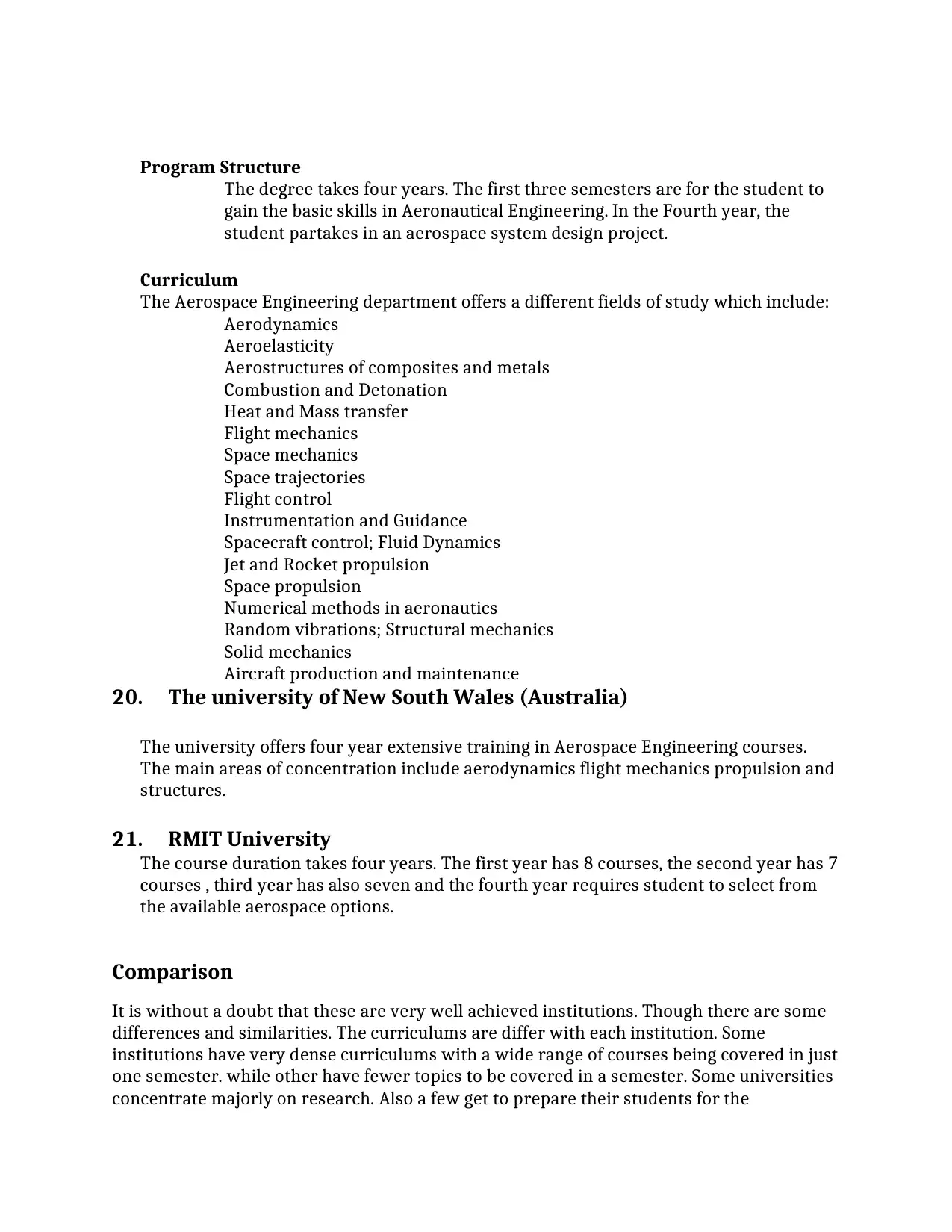
Program Structure
The degree takes four years. The first three semesters are for the student to
gain the basic skills in Aeronautical Engineering. In the Fourth year, the
student partakes in an aerospace system design project.
Curriculum
The Aerospace Engineering department offers a different fields of study which include:
Aerodynamics
Aeroelasticity
Aerostructures of composites and metals
Combustion and Detonation
Heat and Mass transfer
Flight mechanics
Space mechanics
Space trajectories
Flight control
Instrumentation and Guidance
Spacecraft control; Fluid Dynamics
Jet and Rocket propulsion
Space propulsion
Numerical methods in aeronautics
Random vibrations; Structural mechanics
Solid mechanics
Aircraft production and maintenance
20. The university of New South Wales (Australia)
The university offers four year extensive training in Aerospace Engineering courses.
The main areas of concentration include aerodynamics flight mechanics propulsion and
structures.
21. RMIT University
The course duration takes four years. The first year has 8 courses, the second year has 7
courses , third year has also seven and the fourth year requires student to select from
the available aerospace options.
Comparison
It is without a doubt that these are very well achieved institutions. Though there are some
differences and similarities. The curriculums are differ with each institution. Some
institutions have very dense curriculums with a wide range of courses being covered in just
one semester. while other have fewer topics to be covered in a semester. Some universities
concentrate majorly on research. Also a few get to prepare their students for the
The degree takes four years. The first three semesters are for the student to
gain the basic skills in Aeronautical Engineering. In the Fourth year, the
student partakes in an aerospace system design project.
Curriculum
The Aerospace Engineering department offers a different fields of study which include:
Aerodynamics
Aeroelasticity
Aerostructures of composites and metals
Combustion and Detonation
Heat and Mass transfer
Flight mechanics
Space mechanics
Space trajectories
Flight control
Instrumentation and Guidance
Spacecraft control; Fluid Dynamics
Jet and Rocket propulsion
Space propulsion
Numerical methods in aeronautics
Random vibrations; Structural mechanics
Solid mechanics
Aircraft production and maintenance
20. The university of New South Wales (Australia)
The university offers four year extensive training in Aerospace Engineering courses.
The main areas of concentration include aerodynamics flight mechanics propulsion and
structures.
21. RMIT University
The course duration takes four years. The first year has 8 courses, the second year has 7
courses , third year has also seven and the fourth year requires student to select from
the available aerospace options.
Comparison
It is without a doubt that these are very well achieved institutions. Though there are some
differences and similarities. The curriculums are differ with each institution. Some
institutions have very dense curriculums with a wide range of courses being covered in just
one semester. while other have fewer topics to be covered in a semester. Some universities
concentrate majorly on research. Also a few get to prepare their students for the
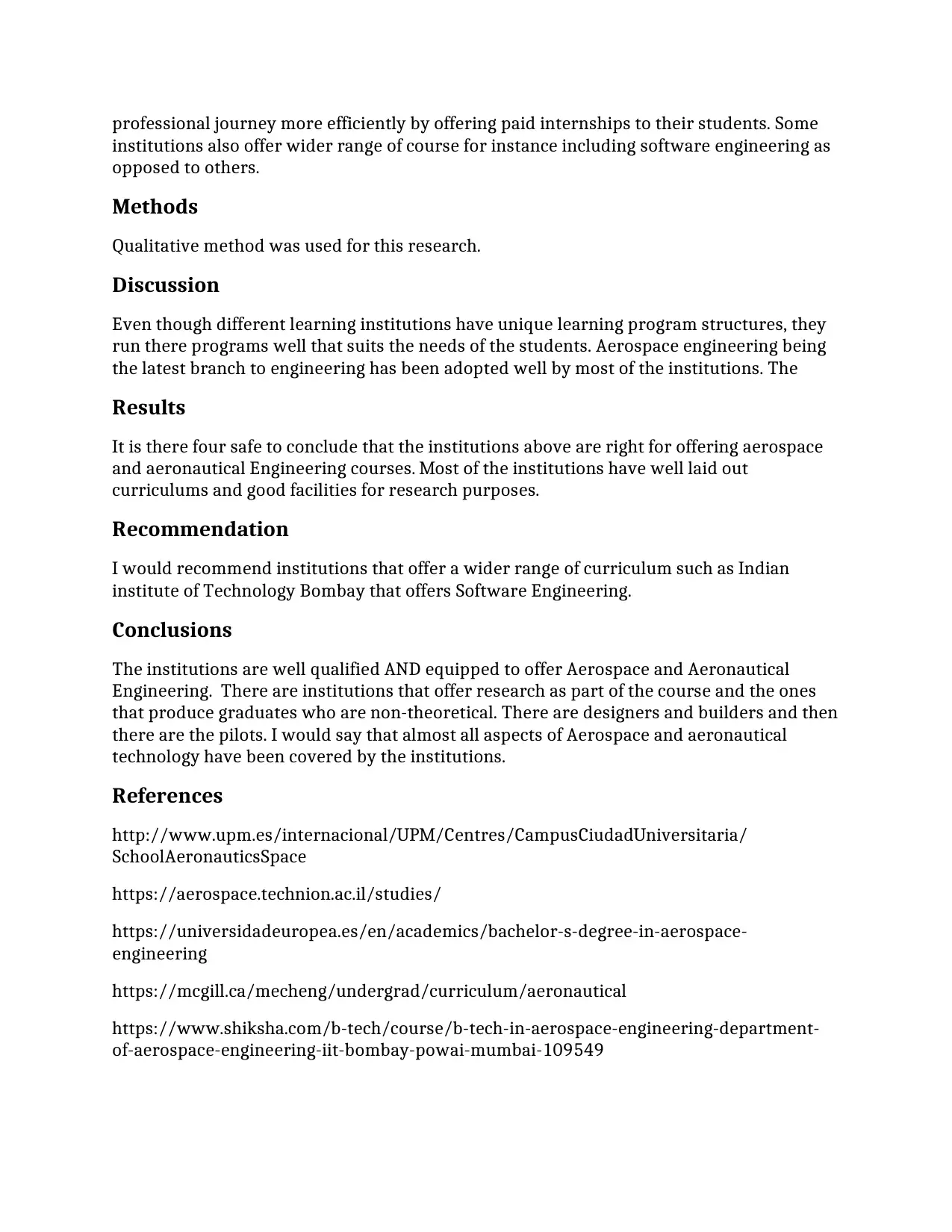
professional journey more efficiently by offering paid internships to their students. Some
institutions also offer wider range of course for instance including software engineering as
opposed to others.
Methods
Qualitative method was used for this research.
Discussion
Even though different learning institutions have unique learning program structures, they
run there programs well that suits the needs of the students. Aerospace engineering being
the latest branch to engineering has been adopted well by most of the institutions. The
Results
It is there four safe to conclude that the institutions above are right for offering aerospace
and aeronautical Engineering courses. Most of the institutions have well laid out
curriculums and good facilities for research purposes.
Recommendation
I would recommend institutions that offer a wider range of curriculum such as Indian
institute of Technology Bombay that offers Software Engineering.
Conclusions
The institutions are well qualified AND equipped to offer Aerospace and Aeronautical
Engineering. There are institutions that offer research as part of the course and the ones
that produce graduates who are non-theoretical. There are designers and builders and then
there are the pilots. I would say that almost all aspects of Aerospace and aeronautical
technology have been covered by the institutions.
References
http://www.upm.es/internacional/UPM/Centres/CampusCiudadUniversitaria/
SchoolAeronauticsSpace
https://aerospace.technion.ac.il/studies/
https://universidadeuropea.es/en/academics/bachelor-s-degree-in-aerospace-
engineering
https://mcgill.ca/mecheng/undergrad/curriculum/aeronautical
https://www.shiksha.com/b-tech/course/b-tech-in-aerospace-engineering-department-
of-aerospace-engineering-iit-bombay-powai-mumbai-109549
institutions also offer wider range of course for instance including software engineering as
opposed to others.
Methods
Qualitative method was used for this research.
Discussion
Even though different learning institutions have unique learning program structures, they
run there programs well that suits the needs of the students. Aerospace engineering being
the latest branch to engineering has been adopted well by most of the institutions. The
Results
It is there four safe to conclude that the institutions above are right for offering aerospace
and aeronautical Engineering courses. Most of the institutions have well laid out
curriculums and good facilities for research purposes.
Recommendation
I would recommend institutions that offer a wider range of curriculum such as Indian
institute of Technology Bombay that offers Software Engineering.
Conclusions
The institutions are well qualified AND equipped to offer Aerospace and Aeronautical
Engineering. There are institutions that offer research as part of the course and the ones
that produce graduates who are non-theoretical. There are designers and builders and then
there are the pilots. I would say that almost all aspects of Aerospace and aeronautical
technology have been covered by the institutions.
References
http://www.upm.es/internacional/UPM/Centres/CampusCiudadUniversitaria/
SchoolAeronauticsSpace
https://aerospace.technion.ac.il/studies/
https://universidadeuropea.es/en/academics/bachelor-s-degree-in-aerospace-
engineering
https://mcgill.ca/mecheng/undergrad/curriculum/aeronautical
https://www.shiksha.com/b-tech/course/b-tech-in-aerospace-engineering-department-
of-aerospace-engineering-iit-bombay-powai-mumbai-109549
1 out of 19
Related Documents
Your All-in-One AI-Powered Toolkit for Academic Success.
+13062052269
info@desklib.com
Available 24*7 on WhatsApp / Email
![[object Object]](/_next/static/media/star-bottom.7253800d.svg)
Unlock your academic potential
© 2024 | Zucol Services PVT LTD | All rights reserved.





